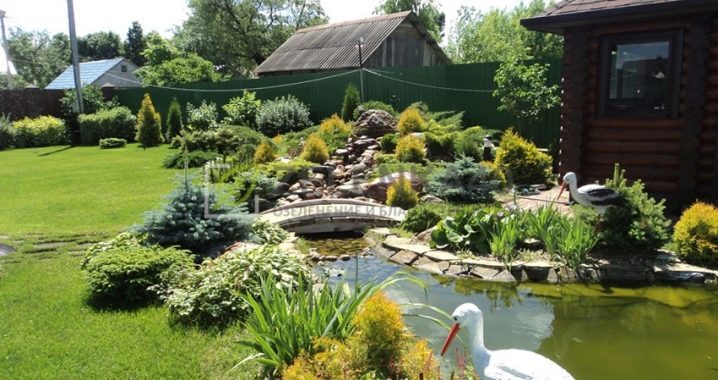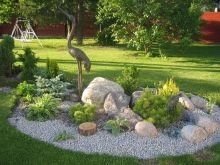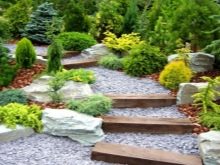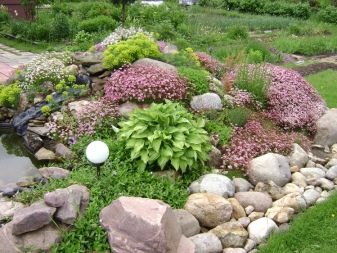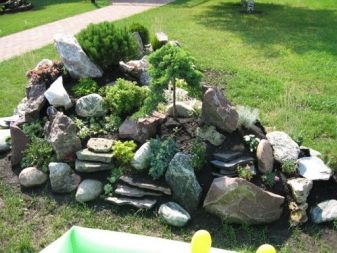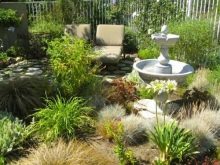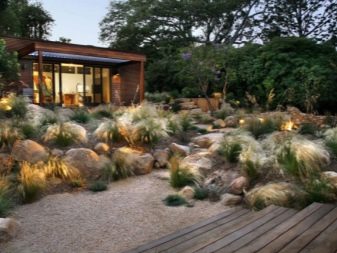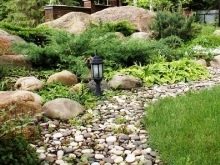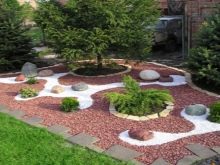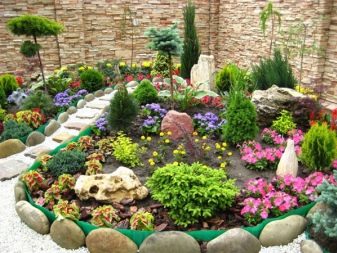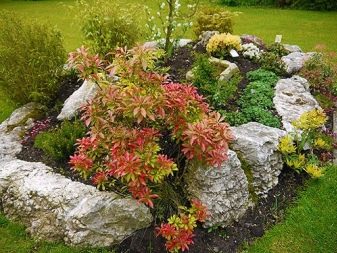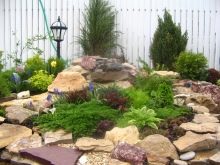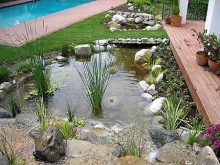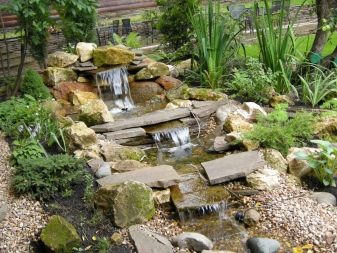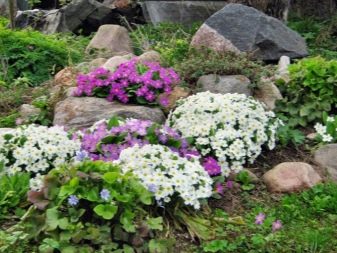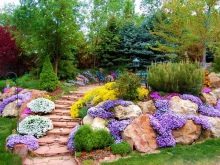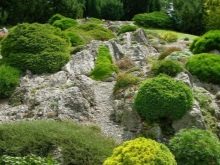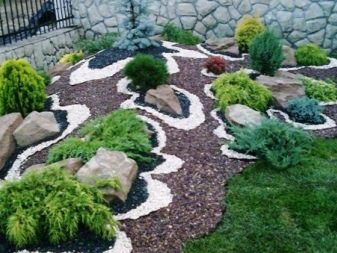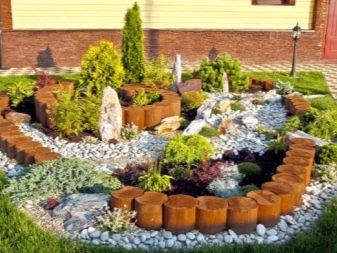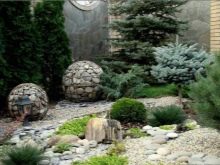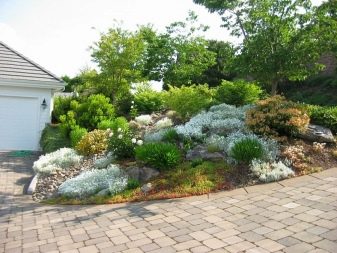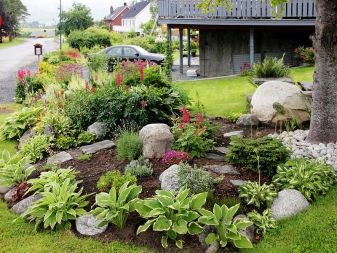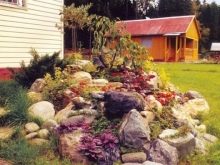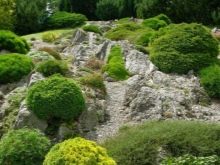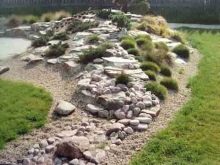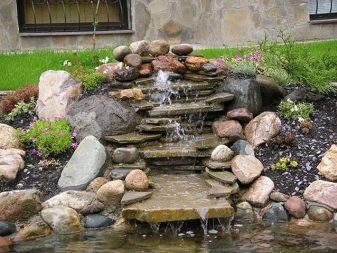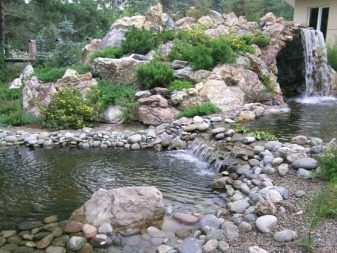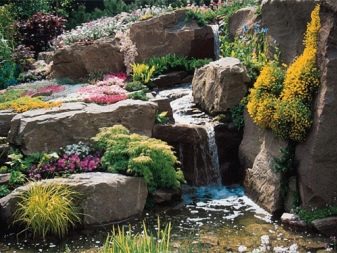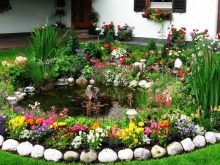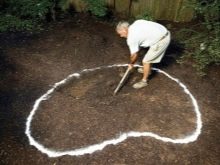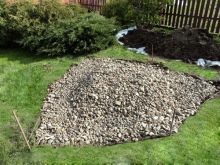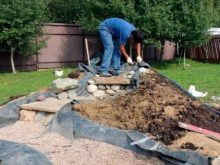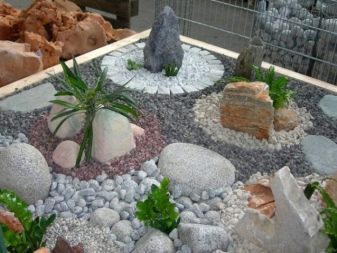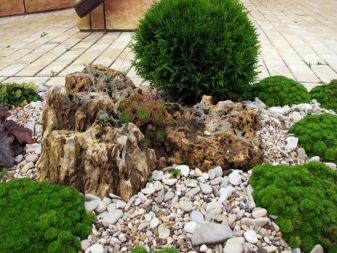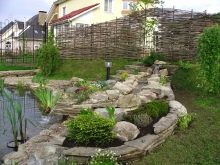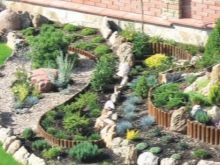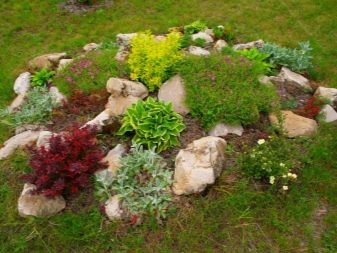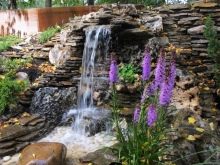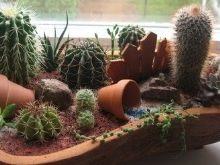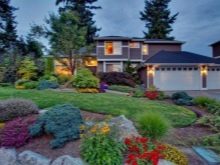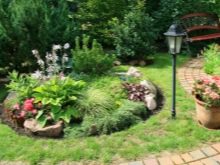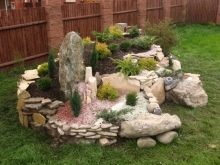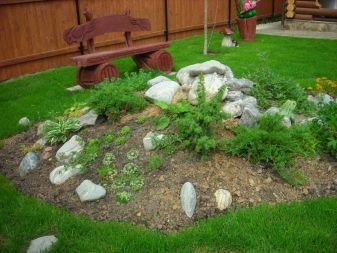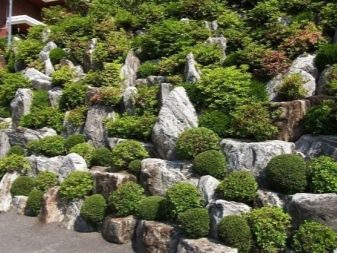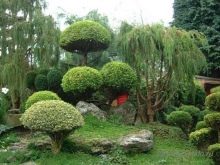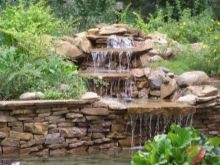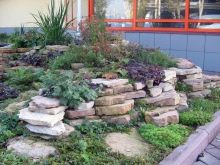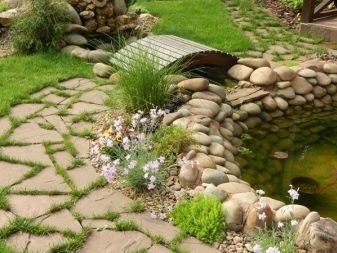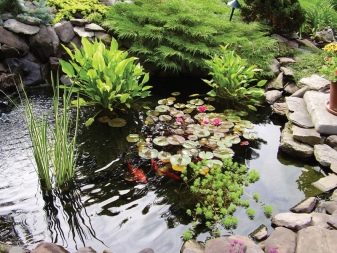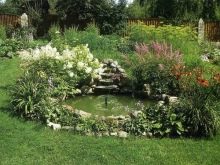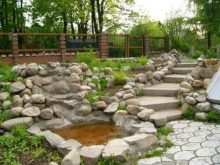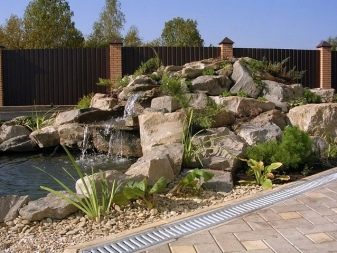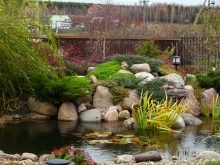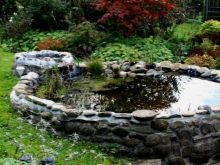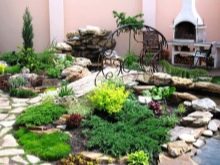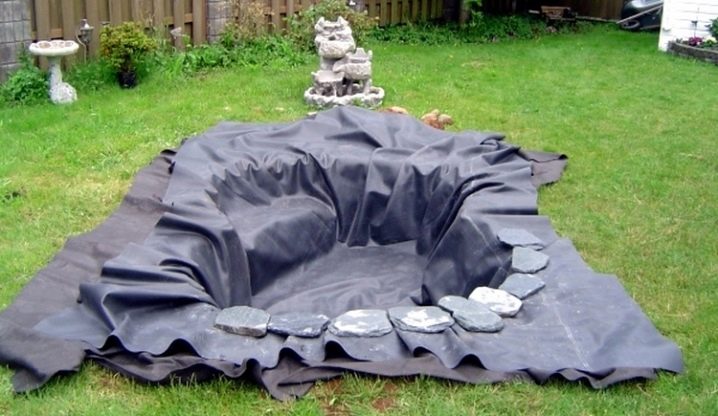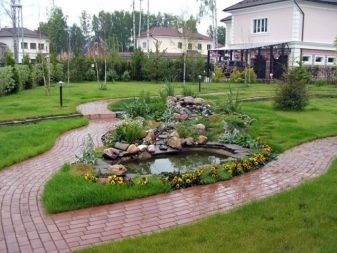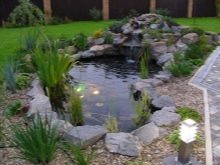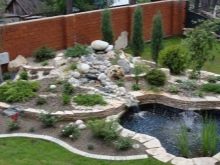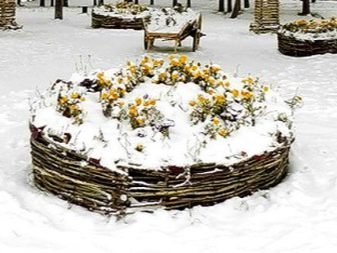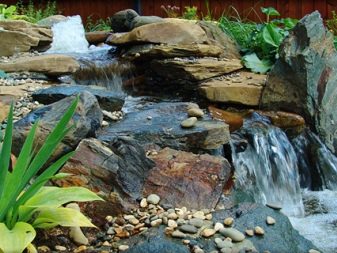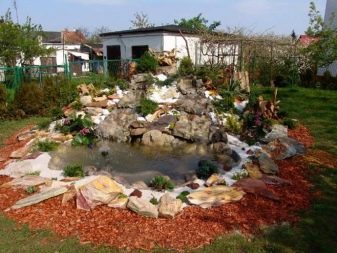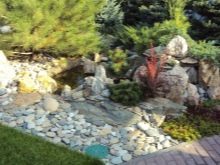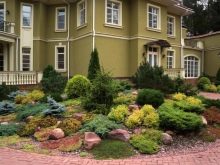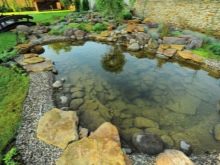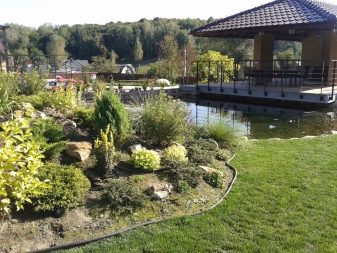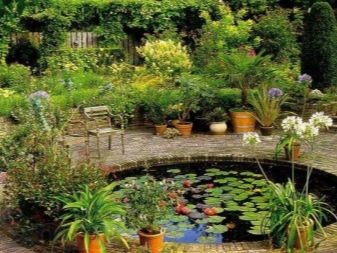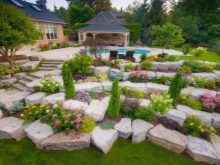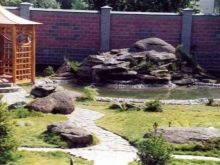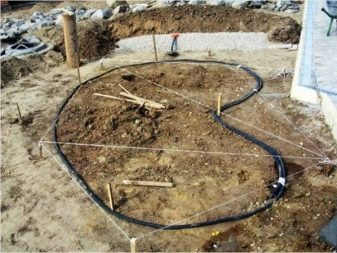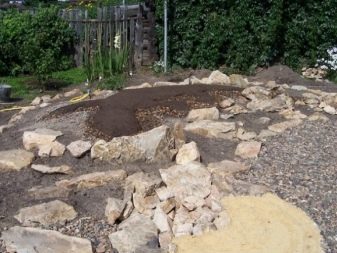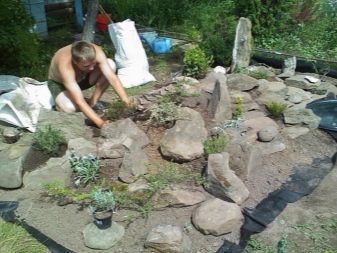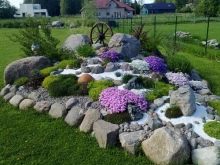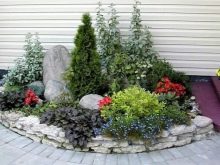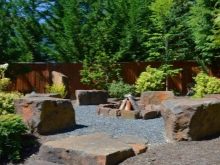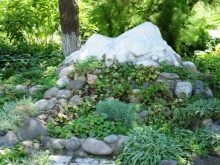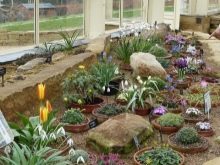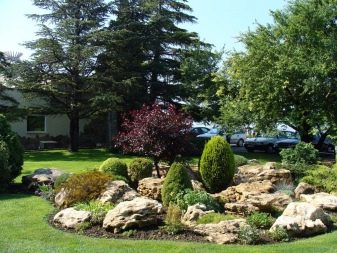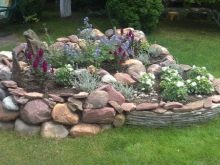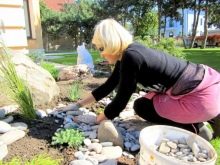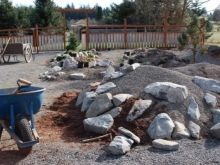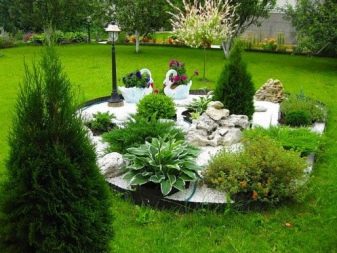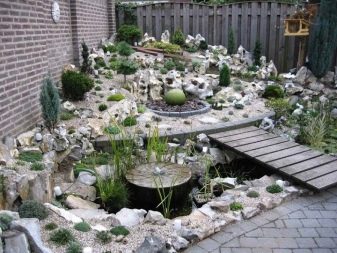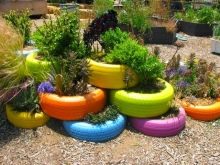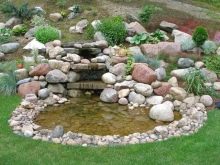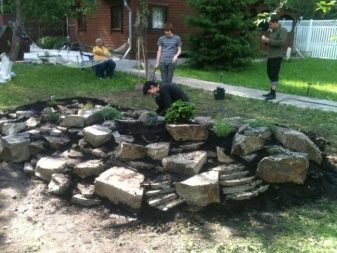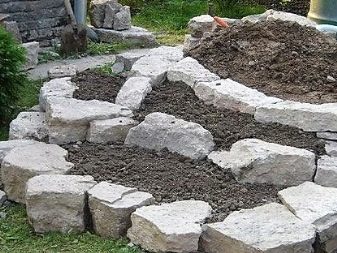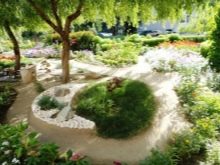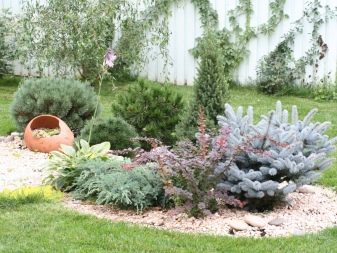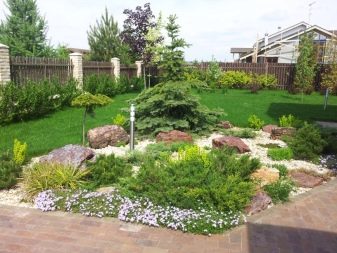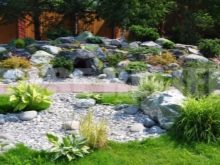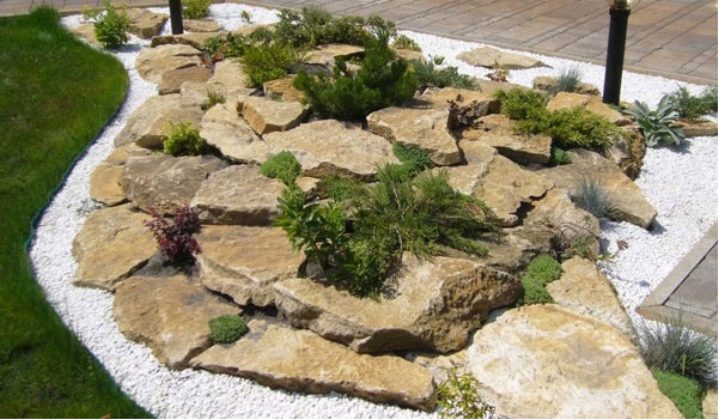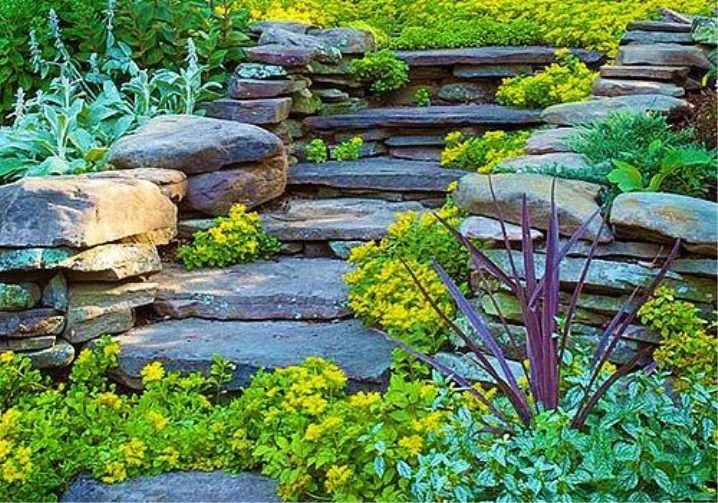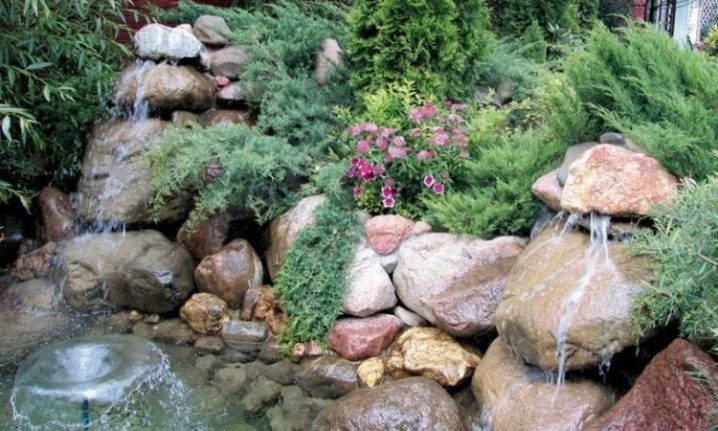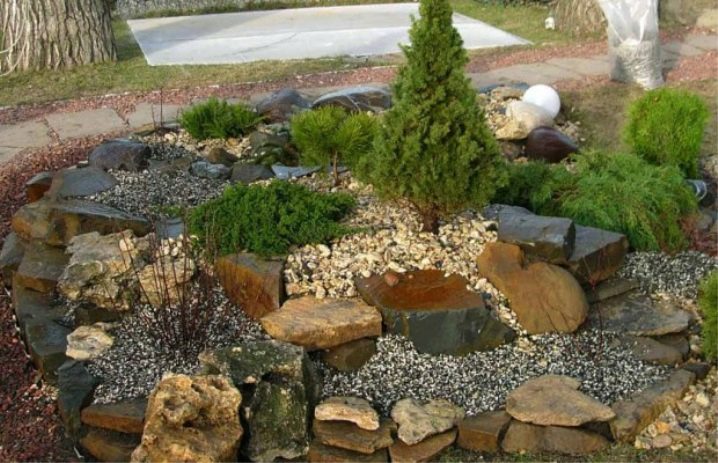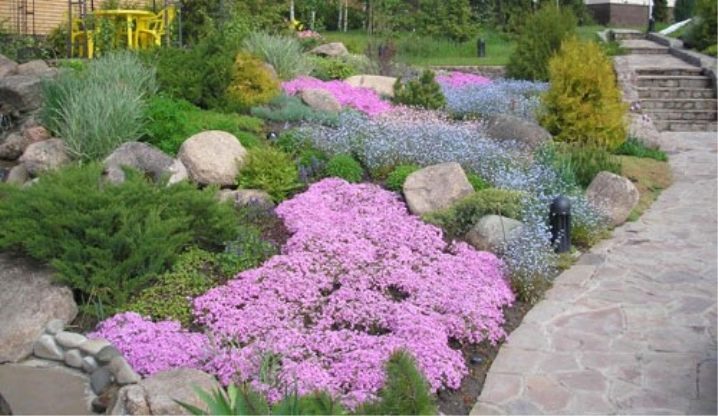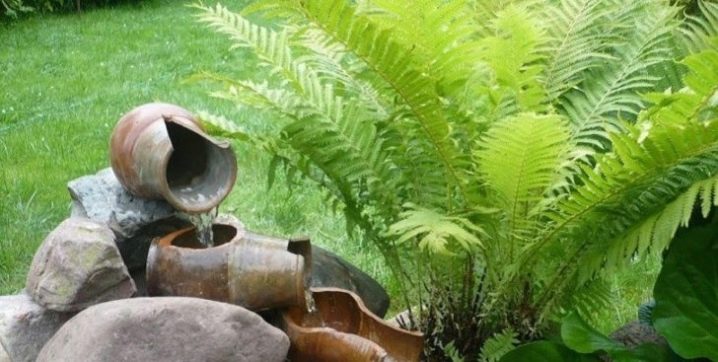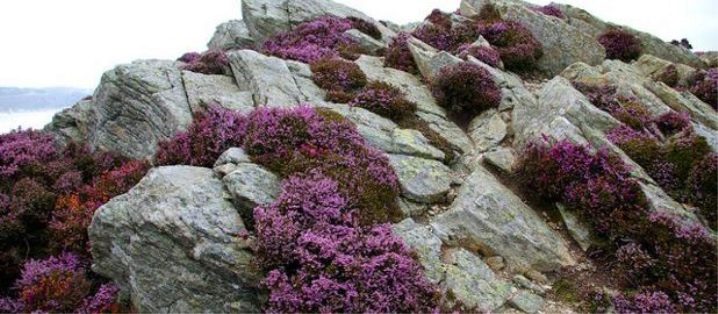Alpine slide: design examples
Rock garden is a construction that requires labor, serious design and preparation. It is necessary to know in advance what pitfalls will be faced in order to prevent possible disappointment. With the right approach, you can get a great composition that will delight for many years.
History of
The history of the alpine slide leads to the land of the rising sun - Japan. Delightful gardens in the stones began to plant it there. The inhabitants of Japan have always experienced a shortage of free space, and therefore sought to surround themselves with beauty on all free patches of land. According to Japanese canons, true beauty is possible only in nature. An unusual combination of lifeless stone and a juicy, mobile plant form true beauty.
In the European countries rock gardens came only in the XVI century.Then they were plots of land, planted with wild plants and flowers.
Today, the alpine slides are inherent in all countries. Many people think about how to build a rock garden on the site with their own hands, without resorting to the services of a landscape designer.
The attractiveness of stone ensembles is a fundamental element of the eastern practice of admiring a garden of stones. Large stones, symbolizing eternity, are not able to resist the imperceptible effects of the sun, rain and wind and eventually turn into sand. Europeans understand little of the meditative effect of Japanese stone gardens. The paradoxical combination of stone boulders and vegetation making their way through is more pleasant for our eyes.
The picturesque nature of the rock garden on the garden, the fragility of flowers and herbs against the background of moss-covered stones brings joy and aesthetic pleasure, relaxes, adjusts to mental activity.
Alpine slide rapture gives way to bewilderment: among the lifeless boulders magnificent flowers grow magnificently. Create a rock garden on your site can each person if you have the desire and a serious approach. This is a challenging job requiring planning and manual labor.. However, if you do everything according to science, garden care will be minimal. The stony garden will be the pride of the owner not only for the whole summer, but also for many years, especially if it was created with his own hands.
Rockery and rock garden: similarities and differences
These concepts are often confused even by experienced gardeners. This is not surprising, because they really have many similar characteristics. The basis of the rock garden and rock aria is the use of stones and plants.
Rockery - This is an ensemble, made mostly of rock alone. This is a classic approach to creating a rock garden. A variety of flowers act only as a background element for stone rocks.
Rock garden - Man-made hill with stones, planted with flowering plants and small shrubs in the form of tiers. The hill is decorated with Alpine and Carpathian plants, but in the Japanese version they plant Far Eastern species, and in the Mexican version - succulents.
Rockery is a composition of stones, created, as a rule, on a flat relief. It consists of rocks of different sizes, a gravel embankment and sand.Rare plants are usually the focal point of the entire ensemble. Japanese rockeries do without plants.
Rock garden differs from rock arias by obvious uneven relief, because rock aquarium is located on a plane. Among its varieties, there are three main styles:
- Japanese rockeries. It is a composition of stones, where plants play a minor role and act as color accents. This option will appeal to lovers of peace and harmony.
- European-style rockery as close as possible to the natural landscape of nature.
- English rockeries different perennial coniferous shrubs that are so fond of the inhabitants of England
In addition to styles, rockeries can be divided into temporary, permanent, and volatile.
Temporary rockeries are organized on a flat or slightly raised area.. It is planted with small seedlings, which will soon become lush plants. The landing pattern should be the size of an adult. Stones and mounds can be changed as the flowers and shrubs grow. The most massive and spectacular boulders are usually reserved for grown plants.
If in the future it is not planned to pay much attention to rockaria, then the so-called “permanent” rockeries will be interesting.. For its construction will require large boulders or smaller stones for their grouping. Rockery is divided into small zones, which are denoted by stones. Such zones will help contain excessive plant growth and keep each of them in its place. Coniferous plants and low-growing shrubs such as spirea, silverweed or barberry will be the most slow-growing and easy to care for.
The basis of the changeable rock aquarium is the planting of new plants every year, with the exception of a few large and permanent individuals that will form the basis of the composition. This variety will provide the dynamics and change of scenery annually.
Application in landscape design
If the site has a natural unevenness, then there is an opportunity to build an alpine slide, because it is not only beautiful, but also very exciting. Already at the preparation stage, a clear work plan is needed: you need to choose boulders and perennials, plant coniferous shrubs, choose a composition for a small garden, and much more.
If the site can not boast of fertile soil, then for the alpine slide, you can use sandy and rocky soil. This soil provides good development and flowering plants.
Types and forms
Rock cliff is the easiest and most popular type of alpine slide. If the site has a natural steep slope - this is a great opportunity to make a hill in the form of a cliff on the slope. Creating a rock garden should begin with the laying of large boulders at the base, and then start planting plants.
An interesting mountain composition is obtained by hiding part of large blocks in the ground and creating pathscreating a unique mountain landscape. The game of flower transitions will further enhance the effect of realism.
It is not necessary to have a natural hill or specifically create a mound for rock garden. You can use the ideas of a beautiful mountain object and perform a competent selection with the distribution of stones and plants.
A flat version of rock garden or rock arias will need some high points — large rocks, trees or bushes. The space between them is strewn with decorative gravel or planted with crawling, ground-covering plant species. Flat rock arias often takes up little space.The best location for him is the frontal part of the garden near the terrace or gazebo.
Even a small budget and lack of free time will not stand in the way of the creation of a rock garden. The main thing is to have the desire.
You can try to create gravel garden. It is a mound of gravel, among which grow steppe and stone-hemlock plants.. In the gravel garden do not use huge boulders. Interesting herbal compositions are planted on evenly scattered pebbles.
The advantages of gravel garden include:
- availability of materials;
- ease of execution;
- suitability for plant growth;
- easy care
To create a "lazy Alps" will need sand, gravel, gravel and special textiles. First of all, the soil is dug up and sifted from weeds. Then it is covered with sand with a layer up to 10 cm. Geotextiles creeps from above, and behind it is gravel.
An interesting analogue of the usual rockeries will be its smaller copy: a garden of stones in miniature, planted with small plants. The main quality of such a composition is mobility. This garden can be broken in a plastic container, basin or ceramic pot.Consequently, it is easy to transfer to any convenient place. When cold weather comes, mini-rockeries can be transported to a greenhouse or shed.Therefore, this option is suitable for plants that love heat.
Alpine lawns are usually part of a large rocky composition. A lawn-rock garden is best placed away from direct sunlight, for example, in the shade of coniferous trees.. They acquire a special charm when the flowering period begins.
The creation of such a structure requires a lot of work and constant monitoring. Flowers grow quickly and begin to harm each other. Such the composition will not be too durable, if not to get rid of weeds in time. Even with regular weeding of plants, it will have to be constantly updated.
The best option is a combination of 2-3 shades. For example, a combination of white and lilac or lilac, pink and white. White color will be in harmony with any color solution, so it will be quite difficult to make a mistake in its combination.
You can visually zoom in on some objects with the help of warm shades, and remove them with cold ones. The use of contrasting colors is always relevant.. Their use helps to emphasize the uniqueness and beauty of each of the elements. Looks much more expressive plant, if around him plant species lower. Different leaves look more impressive against each other.
It is advisable to have one bright element in rock gardens.which will be viewed from different positions, and give the composition completeness. Such an element can serve as an interesting shrub or flowering plant, stream or unusual cobblestone. Due to this emphasis the composition will be perceived as a whole.
Flowers and plants
To create an alpine slide will require some knowledge in botany. It is necessary to have at least a general concept of plant species, their description, combination with each other, and rules of care. The variety of plants depends on the type of slides. For the rocky option on the sunny side suitable drought tolerant vegetation, and for the classic rock garden choose miniature trees, flowering herbs and perennial crops.
With the arrangement of rock arias, such plants as geranium, iberis, chamber, lavender,stonecrop and fescue. As for small-bulb cultures, tulips, crocuses, hyacinths are good for stony hills. These plants begin to bloom in the spring before other flowers, which saves rockeries from an unpresentable view.
If there is a desire to achieve high decoration, then you should take care of planting vegetation that blooms at different times. In this case, such a slide will look great from early spring to autumn and change the “outfits” several times during the season.
Plant height is very important. For example, too high species can interfere with the normal development of low-growing varieties. The brightest elements of the composition should be placed in the foreground.in the most conspicuous place.
A great option for an alpine slide is such small coniferous trees like juniper, spruce, thuja, pine. As for flowering shrubs, most often the preference is given to rhododendrons, Erica, blueberries and lingonberries.
Perennial crops that can be planted on an alpine hill include a short day-lily, bergenia, drooping reed, astilba.
Location maps
While the ground is in a state of shrinkage, it's time to do the drawing up of a scheme, determining the place for stones and choosing plants. Depending on the principle of the location of rock garden stones are the following types:
- rock - a hill with a steep slope and large stones at the base, which are surrounded by small rocks located at the top;
- scree slope - large stones are on top, and various-sized pebbles below create the effect of crumbling rock;
- stone plateau - boulders of different sizes, located in a free way on a flat surface;
- multi-tiered slope - pictorial composition, where each tier is supported by a stone block;
- crevice or ravine - rock garden, created in the recess;
- rocky curb - low wall of flat stone, forming rock garden.
When laying rockeries, in addition to rocks of stone, use river boulders and pebbles.
Combination with water
The highest point of excellence in relation to structures that mimic the natural landscape, is a rock garden with a pond. The murmur of water in the creek and the yellowing leaf passing by make the composition romance and harmony.Some craftsmen do their best to create a rock garden with a real fountain.
If you want to get not just a slide, but an object with a waterfall, you will need to consider the following points:
- the bottom of the reservoir must be completely waterproof;
- a pump that pumps water requires laying the electric wire;
- plants in certain areas will need to pick up, given their endurance to moisture;
- the pond needs regular cleaning;
- In the summer months, koi - Japanese carps look gorgeous in a pond, but their maintenance will be fraught with certain difficulties in the winter period.
For carps, it will be necessary to equip a pit for wintering from 80 cm in depth, and also to install an aeration system there to ensure the survival of the fish when the pond is drawn in with ice.
The bowl for the reservoir must be created simultaneously with the slide. Pond depth usually lowso that you can see well the pebbles and fish floating on the bottom if they are planned. In addition, the shallow bowl of the reservoir is easier to clean. It is necessary to create recesses for the installation of the pump. Electrical cable for him is also at this stage.
Concerning placing the reservoir, it is better to place it northeast of the hill, so that the pond will be in the shadow for some time. This will protect the water from premature flowering.
It is recommended to make the walls of the bowl with a slight slope - it will be easier to place stones on them. The bottom is covered with sand with a layer of 100 mm and is well rammed. Geotextiles are laid on top of the sand, and a waterproofing film of rubber is laid on it. Such the film will easily serve for several decades. It is necessary to leave the free edges abroad of the pit, later they will be buried in the ground.
Then the film is pressed against the stones, and the pond is filled with water from a hose. After this, the folds that appear on the film are smoothed out.
The power of the waterfall pump should be 70 W. It is mounted on a special stand, so as not to touch the bottom, and is properly masked with stones. The device must pass the security check connection. By this time, the rock garden should be laid out to the border from which water begins to flow. Hose down here and masked with stones.
You can decorate the reservoir in different ways. The choice of building materials is now huge, so this process is quite easy. Often in the arrangement of the reservoir used ceramic elements, such as jugs and vases. Near a pond or streamlet it is good to plant moisture-loving plants: bergenia, mosses, ferns, swimsuits.
Season matters
About wintering rock garden need to take care in advance.Those plants that are not adapted to our climate and are unlikely to survive the winter, will have to dig and transplant in tubs. Other plants wrap with agrofiber - this type of material prevents vypryvaniya. Shrub called "hvoynik" must be covered entirely and tied with braid.
Snow will save the hill from severe frosts and wind. It is also desirable to place shields around the perimeter., which can serve as sheets of plywood, slate or parts of old furniture. The pond at rock gardens need to be drained or throw a few rubber balls at it - they will take the pressure of the ice. The pump with hoses must be removed and stored in the country.
When the winter bad weather is over, it is time to prepare a “paradise” near the house for the new season. Already from the beginning of spring it will be necessary to eliminate the consequences of snowfall, blizzards and melt water.
Some plants, unfortunately, die. The stones may have slipped, and the whole round slide is covered with the rotten remnants of a former flower garden. First of all, you need to work with a rake, removing rotten leaves. Then hoist the boulders in place, pour fresh soil and gravel, and then plant the winters in the warmth and add new ones.
How to do it yourself?
The rock garden is built in several stages, each of which has its own nuances. First, it is necessary to determine the size and shape of the hill, and if the construction is complex, it is desirable to draw a diagram of steps, paths and transitions. For the construction of an alpine slide will need:
- stones and pebbles;
- coarse sand;
- ornamental plants;
- moss sphagnum
The construction of the rock garden occurs on a hill with a height of 1 to 3 meters. Work on the design of rock garden is quite possible to carry out on their own, without the help of experts. Flowerbed is quite possible to break their own hands, picking up the picture of a flower carpet to your taste.
Of course, the compositions are of different levels of complexity: from simply planted along the fence of flowers to a complex structure in several tiers. Even in a small area you can build a natural corner to enjoy yourself and your neighbors, because it is so nice to go out on the terrace with a cup of coffee and watch your own alpine meadow and emerald lawn.
Many ideas can be gleaned from ready-made compositions, adding some of its own flavor. This is a very exciting and rewarding work, of which only the most pleasant memories will remain.
Location selection
First, you need to determine a favorable place for rock garden on the site. It is better to keep some distance with perennial shrubs and trees, because they can grow and completely leave the hill in the shade. For the same reason, it is bad to break a rock garden against a wall. The place should be well inspected from all corners of the site and be dry.
To determine the location of the rock garden should be guided by the following rules:
- there should be a good overview from around the garden;
- place better on the illuminated side, not fenced by trees;
- must be protected from the wind.
Excessive groundwater levels will lead to premature destruction of the foundation structure. Moisture in the soil can be reduced by drainage.
Most people prefer to collect rock garden without the use of serious construction work (cementing, creating masonry and the like). This way is less energy consuming and additionally gives an opportunity to remake something.
Training
For the construction of rock garden will need not only picturesque boulders, but rubble with sand. It is necessary to begin work with a marking of the territory by means of a peg and a rope.
Then digging a pit about a meter deep. The dug hole should be covered with layers of broken brick, pebbles and rubble by about 30 cm.. After that, this combination should be poured with water. A mixture of sand and gravel, 5-10 cm thick, is poured on top.
This layer also needs to be poured with water and thoroughly tamped. The soil that was formed during the digging of the bowl, you need to clear the roots, debris and stones and fall asleep over the drainage. It is necessary to give 2-3 weeks to the soil for shrinkage, and then proceed to the laying of stones. Many people prefer to start building a slide in the fall, so that the ground during the winter is a good donkey.
Irrigation and drainage system
There are several options for irrigation of rock garden. Even during the laying of the base, you can install a pipe in the center, the upper part of which will protrude from above. A hose is supplied to it, and all this is camouflaged with stones and moss.
Water into the ground will pass through the holes in the pipe. You can use a spray hose to create a fountain effect.. A stream bed is created from small pebbles, which will feed the plants. This design can be the main decoration of rock garden.
After all the hard work is finished, all that remains is to observe the rapid growth of plants, the care of which is reduced to a simple cutting of peduncles and the formation of bushes. All the difficulties will soon be left behind, and the result can be admired and proud of any one year.
Selection and laying of stones
The most popular in the construction of rock garden stone rocks are rocks, so they are extremely strong and non-porous. Basalt, travertine, granite, slate, sandstone and limestone are also often used. Less suitable materials are shell rock, tuff and dolomite. These rocks have high porosity, therefore, are more susceptible to destruction.
The first and most important criterion for selecting stones is their strength. The composition of stones of different sizes looks more natural..
The color and shape of the stones also matter
Too round or sharp stones do not look quite harmonious. The main thing in work is to achieve maximum naturalness and naturalness. Different color stones do not always look harmonious - it’s better to stick to the same breed, but choose different shapes and sizes.
The overlooked side of the stone must have the most attractive shape, so they will have to be turned over more than once to determine the best combination. If there are any defects on the stones, they must be masked.. When laying it is important to consider their dimensions and weight. Industrial-made boulders rarely look natural, even in a chaotic location. A selection of stones more than two rocks looks overly decorative.
It is necessary to familiarize yourself with the characteristics of plants and flowers that are planned for planting on a hill. Not all roots are able to grow freely in rocks. The soil most often needs to be acidified to reduce the alkali.. Between plants and stones, you can pour gravel - this will serve as the final chord of the composition.
Stones are recommended to purchase in specialized stores. This will guarantee the ecological safety and strength of the rocks. The optimum weight of the product is 100 kg. The average height of the rock garden can reach 1.5 meters.
First install the largest stones. This work must begin after a good shrinkage of the soil. Stones need to be buried in the ground for more than 50% of their volume.. Smaller pebbles should be placed in such a way as to be protected from winds and precipitation, otherwise they will wash and crawl. Do not forget that between the stones you need to leave enough open space for planting plants and flowers.
Construction and arrangement
Vegetation on the hill is selected taking into account the overall design and style of decor. Landscape design involves a variety of rock garden design styles, including rocky terrain, desert garden, lakes with bridges, which are in harmony with the lined structure.
Making your own garden is much cheaperthan to use the services of professional designers. Such work reveals the creative potential and brings a lot of pleasure. Fantasy and imagination will not take long to wait, the main thing is to start.
With ponds and vertical gardening best harmonizes rockeries. Such compositions bring uniqueness and freshness in the decoration of suburban areas.
An artificial rock garden pond can be made from the most unexpected objects. A wonderful addition to the alpine slide can be created from ordinary car tires.In the modern garden they can be used to create a reservoir. The algorithm works as follows:
- find wheels of different sizes - the biggest tire will be the basis of the pond;
- under its diameter we dig a pit;
- fix the tire to the bottom and pour concrete;
- cut off the excess edge;
- the level above we have smaller tires, we also cut off their top, and fill the bottom with concrete;
- we covered the walls with waterproofing film;
- we mask with pebbles and pebbles;
- we mount the pump for water;
- we plant plants that love moisture.
No one would even think that the basis of the reservoir are wheels from the car. It will not take a lot of money to translate the idea, and a refreshing oasis will create a good mood throughout the summer season.
Recommendations for beginners
To get an elegant decoration in the form of a flower-stone composition for your site, you must adhere to the following recommendations:
- it is conditionally necessary to divide the slide into sectors in which there is space for a flat part, scree, rocks and ascent;
- for better perception, it is better to use no more than four spots of different size against the background of greenery;
- Do not use factory decorations.
Each owner gets his own special rock garden, each with its own unique twist. Even the most unexpected things can be useful in working with him. For example, in egg trays it is possible to plant seedlings of flowers in order to later plant them in the ground.
At first, the rock garden will need to add new soil and constant strengthening of stones. The land should be evenly poured and compacted after each watering or rain.
Plants also need attention. Do not forget about the timely watering, cutting of dried flowers and leaves. It is possible several times over the summer to feed the plant, but be careful with nitrogen fertilizers. They excessively affect the growth rate of plants, which is not very good under the compositional conditions. At overfeeding of plants you get neglected overgrowths..
Watering the rock garden is better to carry out the sprayto minimize soil blur. It is good to check the stones for durability - they should not stagger. If necessary, you can use insect repellents, and remove diseased plants immediately. The soil at the site of the diseased plant will also have to be replaced.
Interesting landscape design options
Park areas rarely do without the dazzling beauty of rock garden or rock arias. No wonder that many people want to have such beauty in front of their eyes all the time. It is unlikely that something can be fresher, more beautiful and more charming than such a composition on a personal plot.
Below are interesting examples of rock gardens and rockeries for inspiration, because the work at each site will require a unique project.
An example of a classic rockeries in the Japanese style. A minimum of plants among the lifeless stone landscape.
Ladder-rock garden, formed from flat stone rocks.
An inspiring example of a rock garden with a waterfall.
Alpine hill with conifers of shrubs and decorative mound of multi-colored gravel.
Portable mini rockeries in a concrete bed, cast their own hands. The vegetable part of the composition consists of succulents.
A miniature copy of the mountain landscape.
Rock garden lawn during flowering.
A variant of the use of ceramic products to mask the pipe that supplies water. Fern, as a moisture-loving plant, pleases the owners of juicy greens.
Breathtaking rockeries with ground cover plants.
Mini pond of car tire.
To learn how to make an alpine slide with your own hands, see the next video.
